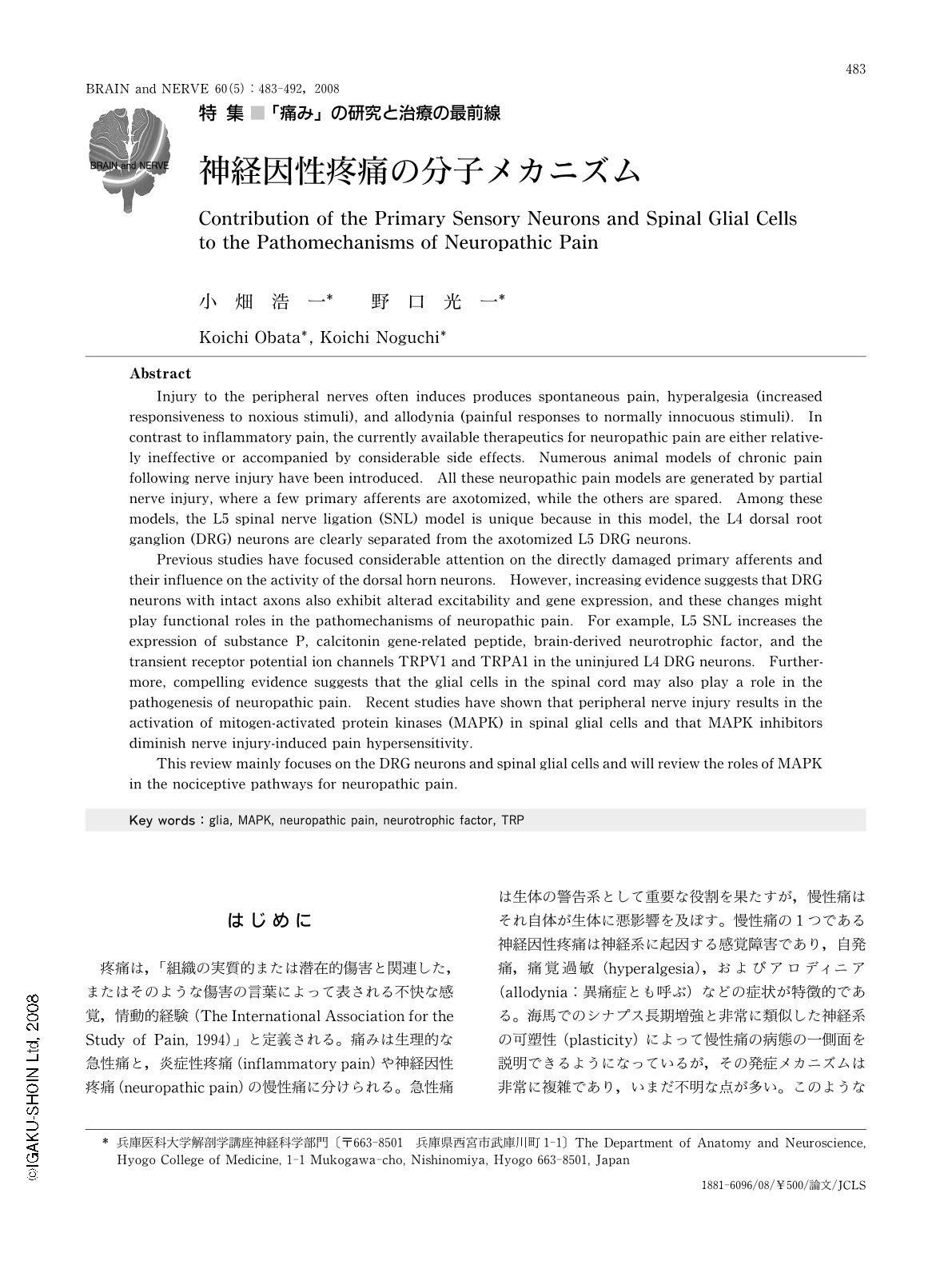Japanese
English
- 有料閲覧
- Abstract 文献概要
- 1ページ目 Look Inside
- 参考文献 Reference
はじめに
疼痛は,「組織の実質的または潜在的傷害と関連した,またはそのような傷害の言葉によって表される不快な感覚,情動的経験(The International Association for the Study of Pain, 1994)」と定義される。痛みは生理的な急性痛と,炎症性疼痛(inflammatory pain)や神経因性疼痛(neuropathic pain)の慢性痛に分けられる。急性痛は生体の警告系として重要な役割を果たすが,慢性痛はそれ自体が生体に悪影響を及ぼす。慢性痛の1つである神経因性疼痛は神経系に起因する感覚障害であり,自発痛,痛覚過敏(hyperalgesia),およびアロディニア(allodynia:異痛症とも呼ぶ)などの症状が特徴的である。海馬でのシナプス長期増強と非常に類似した神経系の可塑性(plasticity)によって慢性痛の病態の一側面を説明できるようになっているが,その発症メカニズムは非常に複雑であり,いまだ不明な点が多い。このような背景から本病態のメカニズム解明に向けてさまざまな動物モデルが作製され,分子生物学的アプローチをはじめとする多角的な研究がなされている。本稿では神経因性疼痛の分子メカニズムについて,一次知覚ニューロンと脊髄グリア細胞の役割を中心に概説する。
Abstract
Injury to the peripheral nerves often induces produces spontaneous pain, hyperalgesia (increased responsiveness to noxious stimuli), and allodynia (painful responses to normally innocuous stimuli). In contrast to inflammatory pain, the currently available therapeutics for neuropathic pain are either relatively ineffective or accompanied by considerable side effects. Numerous animal models of chronic pain following nerve injury have been introduced. All these neuropathic pain models are generated by partial nerve injury, where a few primary afferents are axotomized, while the others are spared. Among these models, the L5 spinal nerve ligation (SNL) model is unique because in this model, the L4 dorsal root ganglion (DRG) neurons are clearly separated from the axotomized L5 DRG neurons.
Previous studies have focused considerable attention on the directly damaged primary afferents and their influence on the activity of the dorsal horn neurons. However, increasing evidence suggests that DRG neurons with intact axons also exhibit alterad excitability and gene expression, and these changes might play functional roles in the pathomechanisms of neuropathic pain. For example, L5 SNL increases the expression of substance P, calcitonin gene-related peptide, brain-derived neurotrophic factor, and the transient receptor potential ion channels TRPV1 and TRPA1 in the uninjured L4 DRG neurons. Furthermore, compelling evidence suggests that the glial cells in the spinal cord may also play a role in the pathogenesis of neuropathic pain. Recent studies have shown that peripheral nerve injury results in the activation of mitogen-activated protein kinases (MAPK) in spinal glial cells and that MAPK inhibitors diminish nerve injury-induced pain hypersensitivity.
This review mainly focuses on the DRG neurons and spinal glial cells and will review the roles of MAPK in the nociceptive pathways for neuropathic pain.

Copyright © 2008, Igaku-Shoin Ltd. All rights reserved.


